Years ending on 1 are somewhat magic for our association: the association was established in 1921, in 1971, our mountainers stood on Nanga Parbat - our first eight-thousander, in 1981 they suceeded in ascending Kangchenjunga. Then Everest became the target.
Slovak and Czechoslovak mountaineering in the beginning did not have conditions and opportunities to contribute into first asccents on highest summits in Himalayas. We lived in a bit another world and doors into the Alps, not to mention more distant mountain ranges, were openning to us only very slowly. Nevertheless, after Caucasus quite logically 1st Czechoslovak expedition into Hindu Kush was in place. The door to the highest mountains was open. Then there were first seven-thousanders in Hindu Kush and Pamir, then Nanga Parbat and first stage was finished with a new route on Makalu in 1976. That was the time when we started to do what the best in the world were doing and in the following years we reached the top level in high altitude mountaineering, although, up to now our contribution in high altitude mountaineering during those years in Pamir was not fully acknowledged world-wide.
Our activities, mainly the first ascent in NE wall of Pik Oshanina in 1978 and climbing the south face of Pik Kommunizma in 1981, both climbed in alpine style, were some of the world's finest achievements in this category. The top level of the classical expedition mountaineering was reached with first ascent of Lhotse Shar via S face and the first ascent of Dhaulagiri via W face in 1984. Both were well-known open Himalayan problems.
Then we contributed into the annals of world's high altitude mountaineering three ascents in the most progressive style. In 1985 it was ascent on Cho Oyu as a first winter ascent on eight-thousander in alpine style and in 1988 it was alpine style first ascent of Dhaulagiri via SW buttress and repeated ascent of Mount Everest via Bonington route but in alpine style. Unfortunately, when descending from Mount Everest, 4 our experienced mountaineers died which caused some setback in our high altitude mountaineering. The world-wide recession in the most progressive activities at highest summits of Himalayas and political and societal changes in our region after 1989 caused that our next generation of mountaineers will need some years to get to the level that we had by the late 80's. This overview that briefly presents our successes can also serve as a foundation for future activities.
In May 12th 1990, when Czech mountaineer Josef Rakoncaj summitted Shisha Pangma, the second lowest 8-thousander, the long-term goal of Czech and Slovak mountaineers to set foot on all 14 main 8-thousander mountains was fulfilled.
But after some 2 and half years this statement had to be revised because Czecho-Slovakia split into 2 independent states. Still, one cannot erase the years of joint Slovak and Czech mountaineering; our activities in Himalayas and Karakoram were common pursuits and cannot be uniquely split or just reduced into Czech and Slovak expeditions.
First attempt in Himalayas was a Tatras expedition (with Czech participation) on Nanga Parbat in 1969, first successful expedition was again on Nanga Parbat in 1971. The summit was reached by Czechoslovak mountaineers: Slovaks: Fiala and Orolín. Slovaks were more active in the beginning, but after 1988, mainly after disaster on Everest, where 4 mountaineers from Bratislava: Becík, Božík, Jasko and Just died, Slovak mountaineering experienced long 6 years pause. At the same time Czech mountaineering with domination of Rakoncaj started to flourish.
Since 1969 till the end of 1995 Slovak and Czech mountaineers tried in 55 attempts, in joint, separate or international expeditions, to reach the 8-thousanders. Two times it was an expedition to a subordinate but independent 8-thousander summit (Lhotse Shar and Yalung Kang). Among 55 attempts 30 were successful. 34 Slovak and Czech mountaineers stood on summits: most frequently Josef Rakoncaj, who 9 times reached the summit of 8 8-thousanders (K2 two times); then Zoltán Demján, Jarýk Stejskal, Leopold Súlovský and Stanislav Šilhán did 3 successful ascents; Dušan Becík, Peter Božík, Jozef Just, Josef Nežerka, Jozef Psotka and Dina Šterbová each have 2 successful ascents and other 23 mountaineers stood on 1 8-thousander.
Slovak and Czech activities in highest mountains were not without tragedies: worst happened on the highest mountain Mount Everest (8848 m), from where five Slovak mountaineers did not return. That is perhaps enough in order to be recorded by a journalist in a book. Although some ascents and attempts were published in books, up to now there was no review available on Slovak and Czech book market. As a journalist working for newspaper Šport I was able to interview many mountaineers and write about progress of expeditions mentioned in this text. Mainly from this source but also from other published articles in Slovak and Czech newspapers and magazines or published books I collected information and evidence for this publication. The name of this book is "From Gasherbrum to Everest" i.e. from the lowest (Gasherbrum II) to the highest 8-thousander but the actual chronological order is different: Slovak and Czech Himalayan history started on Nanga Parbat and Everest was the 6th successfully climbed main 8-thousander...
If we split Slovak and Czech expeditions and count we would see that up to 1995 both Slovak and Czech mountaineers stood on the summits of 10 main 8-thousanders: Slovaks did not stand on summits of Manaslu, Annapurna, Broad Peak, and Shisha Pangma and Czechs had not set foot on Kangchenjunga, main summit of Lhotse, Gasherbrum I and Gasherbrum II. But rich Himalayan history of Slovak and Czech mountaineers is not yet finished...
Taken from the book "From Gasherbrum to Everest" by Milan Vranka
1965
- In the year 1965, the old dream of some generations became the reality - 1st Czechoslovak expedition HINDU KUSH 65. This expedition was very successful. Under the leadership of V. Šedivý the Czechoslovak mountaineers ascended 17 summits in Hindu Kush that were not climbed before. Among those summits 7 were over 6000m high. The Slovak mountaineers Jožo Psotka, Ivan Gálfy a Ivan Urbanovič were also among its members. One peak, 6160m high, they named Koh-i-JAMES. (expedition members: V. Šedivý - leader, R. Antoníček, J. Červinka, I. Gálfy, M. Jaškovský, R. Kuchař, M. Matras, J. Psotka, I. Urbanovič, V. Šmíd).
1967
Year 1967 was rich in expedition activities.
- 2nd Czechoslovak expedition HINDU KUSH 67 with its 13 members operated in the area of @Tirič Mir. They succeeded in 2nd ascent of main summit of Tirič Mir, 7708 m, and I. Gálfy and I. Urbanovič climbed the 1st ascent on Tirič West I., 7487 m (expedition members: V. Šedivý - vedúci, J. Červinka, I. Gálfy, M. Jaškovský, R. Kuchař, M. Matras, J. Psotka, I. Urbanovič)
- The next big event was the international expedition to Pamir, where also 7 Czechoslovak mountaineers (led by Ivan Kluvánek) participated. Main goal was Pik Lenin, which was summited by I. Kluvánek, J. Sláma, I. Goll and S. Chmela.
1968
- In 1968, the mountaineers from the city of Zilina organized under theleadership of Slavomír Chmela a 9-member expedition to Pamir. 6 summits were ascended, including 2 first ascents.
1969
In 1969, 2 independent Slovak expeditions operated in high mountains.
- An expedition of 12 Tatras-born mountaineers led by Ivan Gálfy attempted a difficult ascent of Nanga Parbat. Because of bad weather they reached only 6700m altitude.
- The next expedition was into Pakistani part of Hindu Kush. It was led by Tibor Šurka and had 8 members. Team J. Psotka, J. Zaťko a I. Fiala ascended a virgin summit of Bajpaš-Zom, 6700m and gave it the name Bratislava. The main goal, the 3rd highest summit of Hindu Kush, Istor-o-nal,7398m, was reached by 2 squads, namely: 13.7. J. Psotka and M. Mereš and 15.7. J. Zaťko, I. Fiala. Close to the end of expedition M. Šajnoha ascended unnamed 6100m high peak.
1971
- In 1971, the II. Czechoslovak expedition on Nanga Parbat, 8125m, led by Ivan Gálfy took place. Nanga Parbat became somewhat special to our mountaineers, and so also the 2nd attempt to reach an eight-thousander led to this mountain. The core of extended group comprised of 8 mountaineers from 1969 expedition. The summit tím was Kriššák, Orolín, Fiala, Záhoranský. They put up a small attack tent at the altitude 7600m. They did not carry sleeping bags and so the night before the summit attempt they spent in down jackets and warm-up trousers, all 4 in one small tent. At 3am they started to get ready and at 6am they moved on. Hard conditions and short sleep were seen first on Kriššák. At one point he said to Orolín: "Take my ice axe you will need it more, I go down." Remaining triplet continued in their push, 2 times they needed to use ropes to get through the harder sections. The following terrain looked easy so they left the ropes on the ridge and continued. Suddenly another steep section emerged. Not possible to circumvent and to climb without ropes. Ivan Fiala glanced at the others with the question in his eyes "Who will go to bring them?" Finally, he decided to go himself and they lost some 2 hours while he descended 150m and fetched them. Another obstacle emerged - small ice wall, which meant the end of the journey for Záhoranský. He did not bring his ice axe, Orolín luckily had Kriššák's one. Záhoranský, having only ski poles, said: "I will not risk and climb this without an ice axe." And he turned back at altitude 8000m, very close to the summit. Remaining doublet continued without further problems as the final part of the route was on a wide rocky ridge. They moved slowly, step by step. On 11.7., shortly after 1pm, the 1st mountaineers from Czechoslovakia stood on the summit of an eight-thousander. They were Slovaks: Ivan Fiala a Michal Orolín. (from the book: "Od Gašerbrumu po Everest", Milan Vranka).
They ascended 8125m high summit via the route of Hermann Buhl. It was the 2nd ascent via this route. During this expedition, its members also ascended Rakiotsky peak, 7070m, and did 2 1st ascents: on the minor summit of the Nanga Parbat mountain, 7910m and on SE summit of Nanga Parbat, 7530m. (expedition members: I. Gálfy - leader, M. Filip a F. Dostál - filmmakers, M. Jaškovský, J. Koršala, M. Kriššák, A. Puškáš, I. Urbanovič, I. Dieška, I. Fiala, J. Psotka, M. Orolín, G. Haak, M. Mladoň, Ľ. Záhoranský)
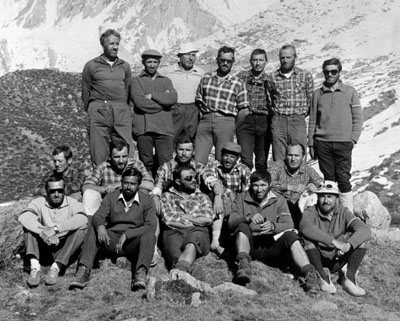
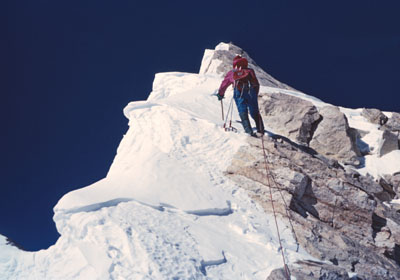
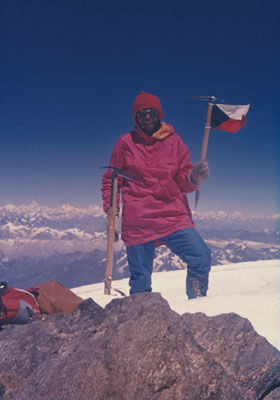
The members of the expedition Nanga Parbat 1971, from the left upper row: Mirek Jaškovský, Gejza Haak, Bohuš Kosmák, Ivan Gálfy, Jožo Psotka, Martin Mladoň, Jožo Koršala, middle row: Ivan Dieška, Ľudo Záhoranský, Ivan Fiala, Milo Filip, Mišo Orolín, lower row: Milan Kriššák, kpt. Zakir, Fero Dostál, Ivan Urbanovič, Arno Puškáš. / Ivan Fiala close to the summit of Nanga Parbat. / Ivan Fiala on the summit of Nanga Parbat. Photo: Michal Orolin.
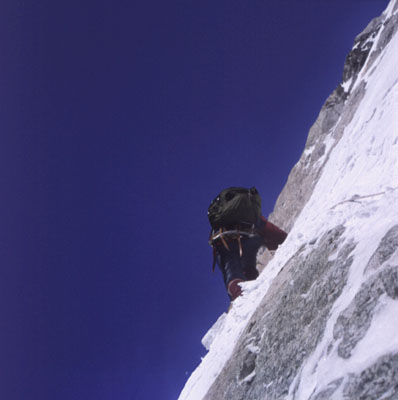
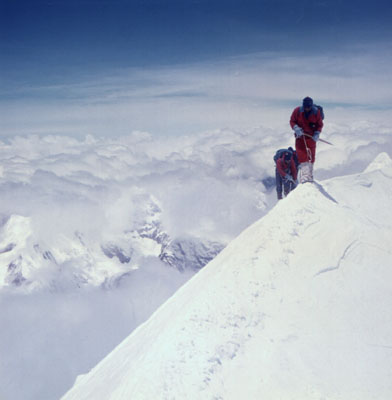
Nanga Parbat: Difficult mixed climb at the altitude 7950 m. / On the ridge of a saddle. Photo: Ivan Fiala.
1973
- Unsuccessfull expedition on Makalu, 8463m, led by Ivan Gálfy. The aim was to make an important 1st ascent via SW buttress of the S face. J. Kounický died during this expedion.
1974
- Expedition to Hindu Kush, comprised by 4 mountaineers R. Mock, L. Páleníček, V. Tatarka a J. Zaťko. They made 1st ascent on Gumbaz-e-Safed, 6800m.
1976
- The II. Czechoslovak expedition on Makalu, 8463m, led by Ivan Gálfy, succeeded to finalize the 1st ascent via SW buttress. The summit was reached on 24.5. by M. Kriššák@, K. Schubert and Spaniard J. Camprubi. K. Schubert died during the descent. (expedition members: I. Gálfy@ - leader, Z. Brabec, J. Červinka, I. Fiala, M. Kriššák, M. Neumann, M. Orolín, L. Páleníček, J. Psotka, I. Novák, M. Pelc, V. Petrík, K. Schubert, S. Talla, J. Wolf a L. Chládek - doctors, F. Dostál a V. Ondruš - filmmakers)
With each solved problem the new horizons and possibilities open. After this success the leader Ivan Gálfy concluded: "Some contemporary problems of the world mountaineering do not reach over 8000m but still they are essential and very popular. There, our new generations should find their place to continue our journey. They should be also encouraged and binded by our current successes."
1977
- In this year, the next Tatra expedition to Hindu Kush was organized and led by M. Neumann. In the Urgend-e-Bala valley they succeeded in 1st ascent via N buttress on Acher Cziogh, 7020m, and 1st ascent direttissima NE face on Kohe Tez, 7015m. Summit squad was comprised by Z. Drlík, M. Kriššák, V. Petrík, M. Neumann, M. Pelc a V. Tatarka.
- The quintuple of mountaineers A. Belica, I. Koller, V. Launer, J. Stejskal a P. Valovič made the 1st ascent on Zhukov Peak, 6852m, in Pamir mountains via SE face with continuation to Pik Lenin.
1978
- The successful expedition on the North summit of Nanga Parbat, 7816m via Diamir wall was led by M. Šajnoha. Summit squad was comprised by A. Belica, J. Just and M. Zaťko. In that time it was the ascent of one of the highest unclimbed summits on the Earth.
- The team Drlík and J. Rakoncaj made the 1st ascent on the Pik Oshanina, 6320m, via NE face with continuation to Peak Rodionova, 6200m. This is one of the most serious Pamir ascents.
- In the Pamir mountains, Ľ. Chrenka, J. Martiš, V. Tatarka and I. Vozárik made the 1st ascent via NW face on the peak Achmadi Donish, 6650m.
1979
- Three mountaineers F. Kele jr., M. Šperka and T. Šurka as the first Slovaks reached the summit of Aconcagua in South America. In the same year, also Czech mountaineer V. Bezděk stood on that summit.
- The team M. Neumann, M. Orolín a E. Myslovskij (Soviet Union) made in the SW face of Pik Revolucii (Revolution Peak), 6974 m, in Pamir mountains the 1st ascent of "Cesta na pamiatku Milana Kriššáka" (The Route in Memory of M. Kriššák), who died in helicopter crash in High Tatras.
1980
- In this year, the expedition to Alaska has taken place. D. Bakoš , M. Orolín, V. Petrík a P. Johson made the 1st ascent on Mount McKinley, 6174 m, via South face (Route in Memory of M. Kriššák).
- Cerro Yerupaja, 6634 m, in Cordillera Huayhuash was climbed via the W face by J. Rakoncaj, J. Stejskal, J. Beneš a M. Nosek.
1981
Two expeditions to Himalayas were prepared:
- The 1st was led by I. Gálfy and was successful on Kangchenjunga, 8598 m. Ľ. Záhoranský and J. Psotka ascended the summit via Japanese route in the N face. (members: Ivan Gálfy - leader, I. Miko - doctor, A. Belica, J. Just, J. Obuch, F. Piaček, J. Porvazník, J. Psotka, V. Tatarka, P. Valovič, Ľ. Záhoranský, M. Zaťko, J. Stejskal, F. Dostál and J. Piroh - filmmakers)
- The 2nd was led by B. Adam and aimed to summit Jannu mountain, 7710 m. They climbed the 1st ascent via NW buttress and then R. Gálfy, I. Vozárik a L. Dívald reached the summit via the France route.
- In Pamir, two demanding routes on Pik Kommunizma were climbed. Three mountaineers Z. Drlík, K. Jakeš and M. Neumann made the 2nd ascent of Myslovsky route in S face, an excellent climb in alpine style. M. Marek and M. Belica made the 1st ascent via N face, for the 60th aniversary of JAMES.
1982
- The team D. Becík and J. Porvazník made the 1st ascent in the W face of Rondoya in the Andes. It is still considered as one of the most difficult routes in this region.
1983
- Josef Rakoncaj as a member of an international expedition climbed on 31. 7. the N buttress on the summit of K2 in expedition style via the Japanese route.
1984
Very busy year in terms of expeditions.
- In Alaska, B. Adam, A. Krížo a F. Korl made the 1st ascent of Mount McKinley via the SW face. In that time it was one of the most technically demanding routes in that area.
5 expedition were active in the Himalayas:
- American--Czechoslovak women expedition was successful on Cho Oyu, 8201m. Dina Štěrbová and an American with Czech ancestry Věra Komárková reached the summit on 13. 5. via the W face. Štěrbová became the 1st woman mountaineer from Czechoslovakia, who ascended an eight-thousander.
- The successful expedition to Lhotse Shar, 8400m, was led by I. Gálfy. They made the 1st ascent in S face in expedition style. The summit was reached on 20.5. by Z. Demján and on 21. 5. by P. Božík, J. Stejskal and J. Rakoncaj. (expedition members: I. Gálfy - leader, M. Zaťko, P. Božík, Z. Demján, R. Gálfy, L. Kyrc, S. Marton, Z. Drlík, K. Jakeš, J. Martiš, I. Novák, L. Páleníček, J. Rakoncaj, J. Stejskal, M. Šmíd, L. Chládek - medical doctor, F. Dostál and E. Fornay - filmmakers)
- The expedition on Dhaulagiri, 8167 m, led by Jirko Novák, made the 1st ascent via the W face by expedition style. K. Jakeš, J. Stejskal and J. Šimon (died on descent), reached the summit. (members: J. Novák - leader, J. Ďoubal, Z. Hofmanová, K. Jakeš, K. Jerhot, R. Kašťák, J. Martiš, B. Mrózek, M. Mžourek, J. Patočka, J. Pelikán - lekár, J. Rybička, P. Schnabl, J. Stejskal, A. Stehlíková, S. Šilhán, J. Šimon, M. Šmíd, P. Rajtár and Italian G. Visentin)
- In the autumn, the Japanese-Czechoslovak expedition on Annapurna reached only the altitude 6000 m. However, they made a valuable 1st ascent on unnamed six-thousander, 6830m, in the ridge of Nilgiri (members: I. Urbanovič sr. - leader of the Slovak part, I. Urbanovič jr. V. Tatarka, J. Michalko)
- The last expedition was on the highest summit on the Earth, Mount Everest, 8848 m. Under the leadership of F. Kele, the triplet Z. Demján, J. Psotka and Sherpa Ang Rita reached the summit on 15.10. They climbed SW face via Polish route in expedition style. During his descent Jozef Psotka died.
"Mount Everest is actually a nine-thousander!" said Slovak mountaineer Zoltán Demján in one of the interviews. (members: F. Kele - leader, Z. Demján, V. Dubeň, I. Fiala, J. Just, V. Launer, R. Mock, M. Orolín, V. Petrík, P. Pochylý, J. Porvazník, J. Psotka, M. Šajnoha, Ľ. Záhoranský, Czech participants: Z. Brabec, M. Neumann, other members: J. Oršula, M. Skladaný and M. Šimunič - doctor, M. Matis and M. Končok - filmmakers)
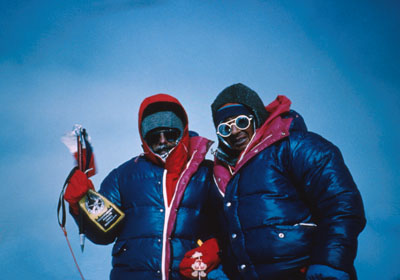
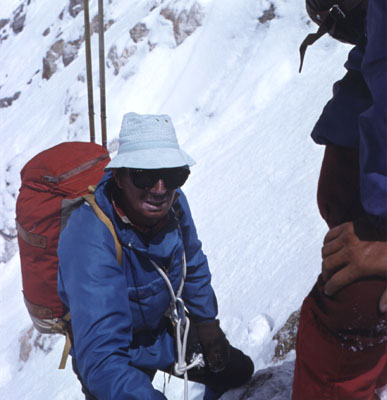
Zoltán Demján and Jozef Psotka on the summit of Mount Everest. Photo from the Z. Demjan's archive. / Jozef Psotka died on Mount Everest in 1984. Photo: Jarýk Stejskal.
1985
- The team D. Becík and J. Stejskal made a unique ascent. They ascended an 8-thousander Cho Oyu, 8201m, in winter alpine style via Messner route. They stood on the summit on 5.12. Winter conditions are not a pleasure. Harsh wind and frost, one is not able to recover even in the base camp.
- After exactly one year the Czechoslovak expedition returned at the foot of the W face of Dhaulagiri with the aim to ascend the SW buttress in both expedition style and, as the 1st ascent, in alpine style. It was again led by J. Novák. On 1.10. the team Božík, Demján, Rakoncaj started to climb SW buttress but bad weather forced them to retreat from the altitude 6600m. The expedition style team also cancelled their attempt.
1986
- Next exciting ascent was by Peter Božík with 2 Poles P. Piasecki and W. Wroz on K2, 8611m. They were first to ascend it via south Magic Line Buttress in light style. They reached the summit on 3.8. Until the altitude 7600m they climbed in expedition style. While descending, Wroz fell from the fixed ropes. In that year, 27 mountaineers stood on the summit of the 2nd highest peak in the world. However, 13 people have died, also a significant figure...
1987
- In this year the Czechoslovak expedition to Mount Everest led by I. Gálfy took place. The aim was to climb a new route in SW face and to climb the Bonington route via light Alpine style. The team Becík, Božík, Rakoncaj, and Stejskal climbed in Bonington up to the altitude 7800m, where the put up 2 tents. In the evening strong gale unleashed and on the next day they had to descend. In the expedition attempt they reached the altitude 8200m but because of bad weather and no time they decided to retreat.
1988
Another very rich year in terms of expeditions, 5 8-thousanders were conquered.
- Fantastic 1st ascent was done by Zolo Demján together with 2 Kazakhs: J. Moisejev and K. Valijev on Dhaulagiri, 8167m, in alpine style via SW buttress. In the 1st part Demján uses the experience from the earlier attempt. After 3 bivouacs they reached the altitude 6700m.
"Here, the actual climbing started," Zoltán Demján describes what followed "Already in first parts I led more difficult sections and higher I already climbed everything as a leader. I was preparing the route, so I became the leader naturally and with no objections and obstacles." After a harsh night, sitting on a small ledge at 7200m, they finished the climb and reached the summit of the buttress. On 6.10. they stood on the summit of Dhaulagiri. After 16 days on the wall they returned to the base camp. They succeeded in an ascent that was later honoured by the UIAA expedition committee as the most valuable in 1988.
- In this year the 2nd expedition on Mount Everest took place. It was a joint Czechoslovak--New Zealand effort to ascend first Lhotse and then Mount Everest via Bonington route (which is assumed to be one of the most difficult routes on Everest) It was led by Ivan Fiala. First, J. Just and D. Becík ascended Lhotse via normal route during the night.
Then team J.Just, J. Jaško, D. Becík and P. Božík attacked Mount Everest via Bonington route in SW face in alpine style. During this ascent 4 lives perished: complete squad of 4 mountaineers who were among our best died during their descent in strong gale. Using the radio Jozef Just claimed his ascent of the summit of Everest. Expedition was comprised of (Slovak part): I. Fiala (leader), D. Becík, P. Božík, J. Jaško, J. Just, J. Orčula, E. Hasík, M. Skladaný - doctor.
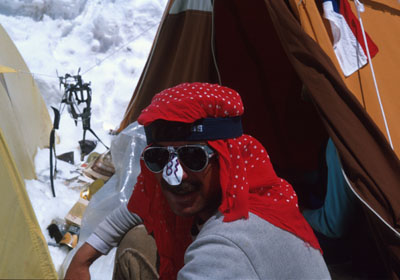
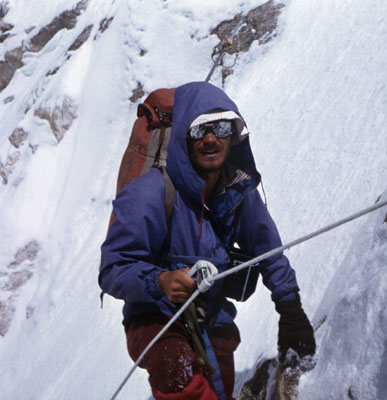
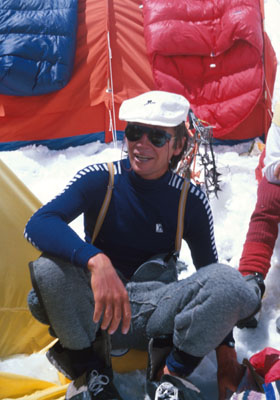
Peter Božík died on Mount Everest in 1988. / Jozef Just died on Mount Everest in 1988. / Dušan Becík died on Mount Everest in 1988. Photo: Jarýk Stejskal.
- The next important expedition, that included women mountaineers, was from the city of Košice and they put off into Karakoram. Gasherbrum I (Hidden Peak), 8068m, was reached by R. Gálfy and I. Urbanovič jr. via North gully in alpine style and by F. Šoltés via Messner's route in alpine style. Gasherbrum II, 8035m, was reached by women L. Klembárová and D. Šterbová via Austria's route. The ascent of GII took them 3 days starting from I. camp at altitude 6000m. It was without porters and without supplemental oxygen and using fixed ropes, that in length 1500m were put up by Austrian and French expeditions. They reached the summit on 25.6 at about 1pm. (members of the expedition: R. Gálfy - leader D. Štěrbová, L. Klembárová, A. Blažej, F. Kele, A. Križo, J. Križo, J. Novotný, H. Semanová, F. Šoltés, I. Urbanovič jr., Z. Vrúbel).
1989
- In Tian Shan, the team Z. Demján and J. Nežerka climbed Chan Tengri, 6995m, via combining the routes of Studenina and Myslovsky.
After 1989, the Slovak high altitude mountaineering had a break and activities did not resume until 1994.
1994
- After 6 years pause from the tragedy on Everest the next expedition into Himalayas took place and was directed on Shisha Pangma. Because of bad weather, they ended the expedition when they reached 6900m. Eva Böhmová said "For sure I do not want this to be my first and last attempt in Himalayas. We, including me, would like to be back here at Shisha Pangma in 1996". However, she was not able to fulfil her dream: 3 months after coming back she died while ascending Bielovodska veza in High Tatras. (members of the expedition: P. Čaplický - leader, J. Svrček, F. Hudek, J. Hreus, E. Böhmová, J. Baláž, M. Styk)
1995
- First time from founding the independent Slovak and Czech Republics in 1993, the joint Czech-Slovak expedition set off into Himalayas. The aim was to ascend Cho Oyu from Tibetan side via an easy normal route in W face. Drda and Myšík reached the top on 2.10, then Louka on 3.10., Kardhordó and Srovnal on 6.10. and Hromádka on 8.10.
"When I spotted the prayer flags flapping in the wind it was only some 20m to the top." said later Juraj Kardhordó "I waited for Srovnal. He came and gave me a hug and we finished the ascent together. His first words on the top were: Ďuro, all the best for your birthday! My eyes got wet, I dropped on my knees and, watched Everest far on the horizont and thought about our 4 mountaineers who did not return from there." (members of the expedition: Czechs: J. Novák - leader, L. Drda, O. Louka, V. Myšík, O. Srovnal; Slovaks: T. Hromádka, J. Kardhordó)
- Mera Peak, 6654m, Vlado Ceniga reached the summit on 14.10. as the only Slovak member of the Czecho-Slovak expedition. He was the first Slovak to ascent Mera Peak.
1996
This year confirmed the increase of Slovak mountaineering activities in the highest mountains.
- During the spring the Slovak ski mountaineering expedition to Shisha Pangma, 8048m, led by P. Šperka, was carried out. On 1.5. Sluka and Šperka summited the peak but then Sluka died while descending. (members of the expedition: P. Šperka - leader, V. Brož, J. Matlák, Š. Sluka, M. Šuna, V. Tatarka)
- In April, Slovak Vlado Zboja as a member of a Czech expedition climbed the summit of Pumori, 7145m, via classic route in SE face, 5, ice 85 degrees in alpine style.
- In the autumn it was an expedition on Lhotse, 8516m, via W face. V. Zboja and P. Hámor reached an altitude 7350m.
- Slovak Martin Gablík as a member of Czech expedition reached the highest altitude from among the members of the expedition: 8000m
- In May, two mountaineers from the city of Zilina, J. Hreus and J. Svrček climbed Mount McKinley via West Buttress route with a new variant in NW wall, ice up to 75 degrees.
1997
- In the spring, a strong Slovak expedition led by J. Stejskal put off into Himalayas. They aimed to climb Kangchenjunga, 8586m, via Slovak variant of the Japanese route established in 1981. The team Kardhordó, Vonderčík returned from the altitude 8500m, less than 100m of altitude from the summit. (members of the expedition: J. Stejskal - leader, M. Gablík, S. Glejdura, T. Hromádka, J. Kardhordó, J. Martiš, V. Plulík, J. Vonderčík, P. Barabáš - cameraman, P. Francisci - doctor, B. Mládek - technician)
- On 12.5. P. Čaplický and I. Kanka reached the summit of Mera Peak, 6654m, as members of a Czech-Slovak expedition.
- On 6.5. Vlado Štrba stood on the summit of Cho Oyu, 8201m, as a member of an international expedition led by J. Novák. He was the 5th Slovak to summit Cho Oyu. I. Urbanovič was also a member of this expedition.
- In the summer, Juraj Kardhordó, as a member of Czech commercial expedition led by J. @Novak@, summited two 8-thousanders: Hidden Peak, i.e. Gasherbrum I, 8068m, (on 9.7.) and then Gasherbrum II, 8035 m (on 17.7.). They were his 2nd and 3rd 8-thousanders.
- In the autumn, an expedition to Manaslu, 8163m, was organized. Manaslu was that time one of the last 8-thousanders not yet summited by Slovaks. The expedition was led by P. Šperka. Most of the time they had quite bad weather and conditions. On 8.10. P. Šperka, M. Rybanský and probably also J. Kardhordó reached the summit. Kardhordó did not return from the summit, he probably fell from the summit ridge and Rybanský died during descent after sudden heart failure. (members of the expedition: P. Šperka - leader, M. Červienka, A. Hanušin, M. Jakubík, K. Juríček, J. Kardhordó, M. Kosmák, M. Rybanský, M. Šuňa, V. Tatarka, E. Truchlíková)
- Big tragedy happened on Pumori. Three Slovak mountaineers P. Lenčo, P. Dzúrik and F. Miščák with one Czech mountaineer fell about 150m above a saddle in an ice wall. All 3 Slovaks died.
- On 28.9. V. Zboja, as a member of an international expedition summited Cho Oyu.
1998
- In the spring a controversial Slovak-Chinese mountaineering-filming expedition to Mount Everest, 8848m, took place. It had some political context. On 19.5., using the supplemental oxygen, V. Zboja and P. Hámor stood on the summit of Everest, where they raised in addition to Slovak and Chinese flags also a flag of a political party. One day later V. Plulík reached the summit without the supplemental oxygen.
(expedition members: P. Lazar - leader of the climbing part, V. Zboja, P. Hámor, V. Plulík, J. Dutka, S. Glejdura, M. Heuger, T. Hromádka, P. Jackovič, R. Jelenský, J. Vonderčík, M. Packo)
- An international expedition on Broad Peak led by V. Štrba reached an altitude 7700m. 4 Slovak mountaineers were among its members: M. Gablík, V. Štrba, P. Šperka and M. Jakubík. French members E. Escoffier and P. Bessieres got lost during the ascent and became missing.
- At the end of the summer, an army expedition on Shisha Pangma, 8046m, took place. The summit was reached via classic route on 24.9. by J Matlák, Sherpa Pemba, M. Červienka and E. Bizoň and on 25.9. by V. Švancár, M. Smilka and J. Janda. (expedition members: J. Matlák - leader, J. Janda, M.Smilka – medical doctor, V. Paulík, P. Velkov, V. Švancár, B. Kurák, L. Demko, E. Bizoň, K. Juríček, M. Červienka and S. Chrappa).
1999
Czech-Slovak expedition to Trango made the first ascent on Trango Pulpit. It was comprised of Czechs I. Wondráček, T. Rinn, P. Weisser, M. Draššár and Slovak J. Dutka. The route has 2100m and is graded 7, A2. Later, on 29.7., Dutka, Weisser and Rinn eventually climbed the main summit of Great Trango via American route.
- In the spring, 11-member women expedition led by A. Čaplická was acting at Imja Tse (also called Island Peak), 6189m. Two members of the expedition summited the peak: I. Svrčeková, Mária Meleková (expedition members: A. Čaplická - leader, M. Nováková, V. Michalíková, I. Karchová, I. Svrčeková from Žilina, Ľ. Kečková from Kysucké Nové Mesto, J. Medzová from Bratislava, M. Gablíková with daughter from Zvolen, M. Meleková and J. Lišaníková from B. Bystrica).
- In the summer an expedition on Muztagh Ata, 7546m, in Chinese Pamir was carried out. V. Ceniga and A. Matušný stood on the summit. The ascent was not technically difficult, no climbing was needed, it was a ski mountaineering ascent on skis with skins up to the summit. (expedition members: V. Ceniga, R. Hornák, M. Lipták, A. Matušný, M. Parocki, A. Vojček and J. Zaťko)
2000
- In the spring M. Heuger and P. Packo ascended Ranrapalcu, 6122m, in Peru, via Simpson Ridge.
- Slovak Army expedition ascended Pik Lenin, 7134m, in Pamir. J. Matlák and V. Švancár ascended the summit via classic route during very bad windy weather.
Literature:
Milan Vranka: Od Gasherbrumu po Everest.
Ivan Dieška: Horolezectvo zblízka.
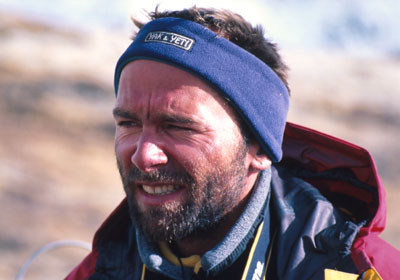
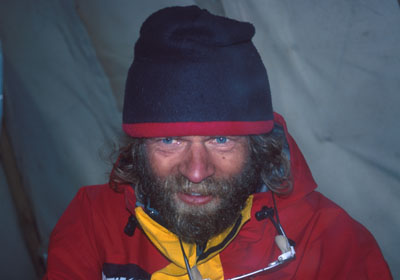
Juraj Kardhordó died on Manaslu in 1997. / Jindro Martiš died while on a trek in Himalayas in 1997. Photo: Jarýk Stejskal.
translation Ľubor Fraštia